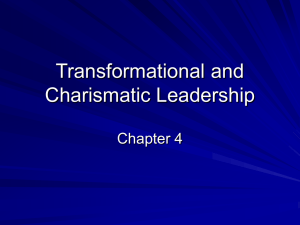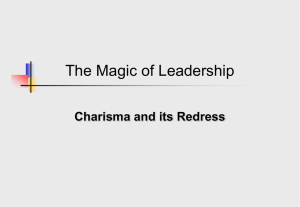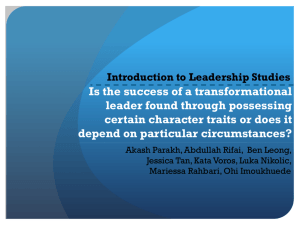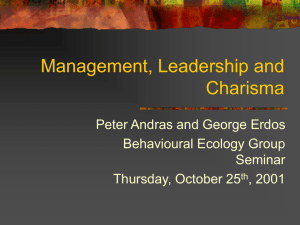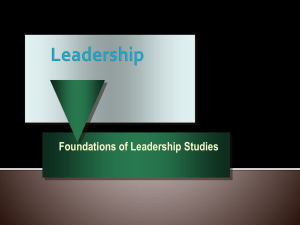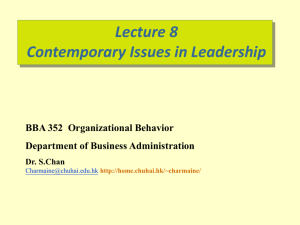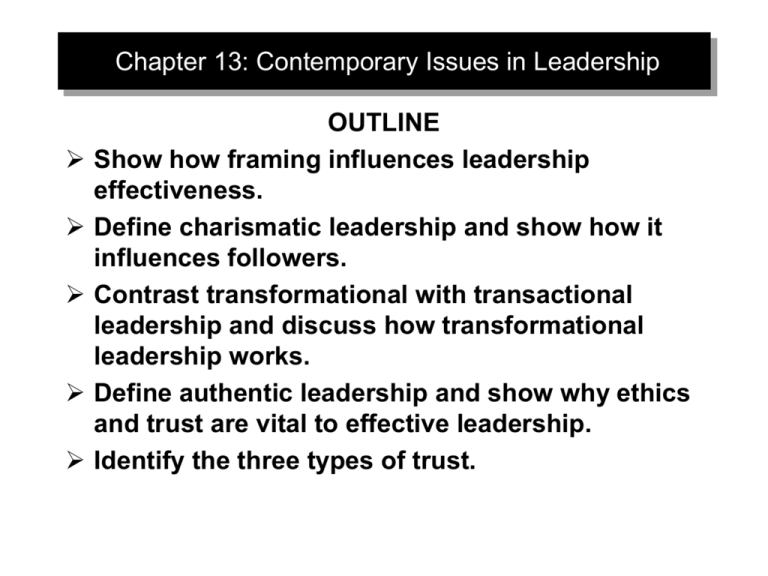
Chapter 13: Contemporary Issues in Leadership
OUTLINE
Show how framing influences leadership
effectiveness.
Define charismatic leadership and show how it
influences followers.
Contrast transformational with transactional
leadership and discuss how transformational
leadership works.
Define authentic leadership and show why ethics
and trust are vital to effective leadership.
Identify the three types of trust.
Inspirational Approaches to Leadership
The focus is leader as communicator
Framing:
– A way of communicating
that shapes meaning
– Selective highlighting
of facts and events
– Ignored in traditional
leadership studies
Two contemporary leadership theories:
– Charismatic Leadership
– Transformational Leadership
Charismatic Leadership
House’s Charismatic Leadership Theory:
Followers make attributions of heroic or extraordinary
leadership abilities when they observe certain behaviors
Four characteristics of charismatic leaders
Traits and personality are related to charisma
People can be trained to exhibit charismatic behaviors
Beyond Charisma: Level-5 Leaders
Very effective leaders who possess the four typical
leadership traits:
– Individual competency
– Team skills
– Managerial competence
– Ability to stimulate others to high performance
Plus one critical new trait…
– A blend of personal humility and professional will
– Personal ego-needs are focused toward building a great
company
– Take responsibility for failures and give credit to others for
successes
Transactional and Transformational Leadership
Transactional Leaders
– Leaders who guide or motivate their followers in the
direction of established goals by clarifying role and task
requirements
Transformational Leaders
– Inspire followers to transcend their own self-interests for
the good of the organization; they can have a profound
and extraordinary effect on followers
Not opposing, but complementary, approaches to
leadership
– Great transformational leaders must also be transactional;
only one type is not enough for success
Characteristics of the Two Types of Leaders
Transactional
Contingent Reward:
– Contracts exchange of rewards
for effort, promises rewards for
good performance, recognizes
accomplishments
Management by Exception:
– Active: Watches and searches
for deviations from rules and
standards, takes corrective
action
– Passive: Intervenes only if
standards are not met
Laissez-Faire:
– Abdicates responsibilities, avoids
making decisions
Transformational
Idealized Influence:
– Provides vision and sense of
mission, instills pride, gains
respect and trust
Inspiration:
–
Communicates high
expectations, uses symbols to
focus efforts, expresses
important issues simply
Intellectual Stimulation:
–
Promotes intelligence,
rationality, and problem solving
Individualized Consideration:
– Gives personal attention,
coaches, advises
Full Range of Leadership Model
Leadership styles listed from passive to very
active
Note the ineffective styles are mostly
transactional
It is all about influencing followers
© 2009 Prentice-Hall Inc. All rights reserved.
13-7
Issues with Transformational Leadership
Basis for Action:
– Transformational leadership works by encouraging followers to
be more innovative and creative and by providing ambitious
goals
Evaluation Based on the Research:
– This theory does show high correlations with desired outcomes
– This style of leadership can be taught
Transformational vs. Charismatic Leadership:
– Similar concepts, but transformational leadership may be
considered a broader concept than charisma
– Instrument-based testing shows the measures to be roughly
equivalent
Authentic Leadership: Ethics and Trust
Authentic Leaders:
– Ethical people who know who they are, know what they
believe in and value, and act on those values and beliefs
openly and candidly
– Primary quality is trust
Build trust by:
– Sharing information
– Encouraging open communication
– Sticking to their ideals
Still a new topic; needs more research
Ethics, Trust, and Leadership
Ethics touch on many leadership styles
– As the moral leaders of organizations, CEOs must
demonstrate high ethical standards
– Socialized charismatic leadership: leaders who model ethical
behaviors
Trust:
– The positive expectation that another person will not act
opportunistically
– Composed of a blend of familiarity and willingness to take a
risk
– Five key dimensions: integrity, competence, consistency,
loyalty, and openness
Five Key Dimensions of Trust
Integrity
– Honesty and truthfulness
Competence
– An individual’s technical and interpersonal knowledge and skills
Consistency
– An individual’s reliability, predictability, and good judgment in
handling situations
Loyalty
– The willingness to protect and save face for another person
Openness
– Reliance on the person to give you the full truth
Three Types of Trust
Deterrence-based Trust
– Trust based on fear of reprisal if the trust is violated
Knowledge-based Trust
– Trust based on behavioral predictability that comes from
a history of interaction
Identification-based Trust
– Trust based on a mutual understanding of one another’s
intentions and appreciation of the other’s wants and
desires
Basic Principles of Trust
Mistrust drives out trust
Trust begets trust
Trust can be regained
Mistrusting groups self-destruct
Mistrust generally reduces productivity



